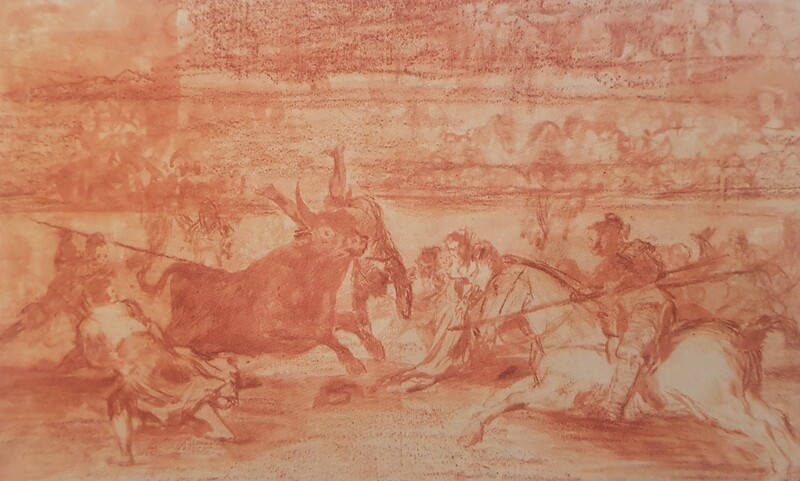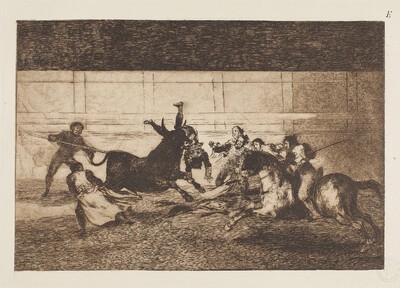- Cronología
- Ca. 1814 - 1815
- Ubicación
- Hamburger Kunsthalle, Hamburg, Germany
- Dimensiones
- 190 x 313 mm
- Técnica y soporte
- Reconocimiento de la autoría de Goya
- Undisputed work
- Titular
- Hamburger Kunsthalle
- Ficha: realización/revisión
- 03 Oct 2021 / 22 Jun 2023
- Inventario
- (Inv. 38533)
See How the ancient Spaniards hunted bulls on horseback in the countryside.
Line of provenance: [José Atanasio Echeverría, Mexico]; Julian Benjamin Williams, Seville (d. 1866); John Wetherell (?) (d. 1865); Horatio / Nathan Wetherell (?) (until 1874); Frederick William Cosens, London (1874-1890); Sotheby's, London, auction of Frederick William Cosens' estates (11-21 November 1890); Bernard Quaritch Ltd, London (November 1890-July 1891); acquired by the Hamburger Kunsthalle on 14 July 1891.
This is one of the four preparatory drawings for Bullfighting and its Extensions held by the Hamburger Kunsthalle (28a, 32b, Ea and Ka) and one of the few of the series and its extensions not in the Prado Museum, Madrid.
See How the ancient Spaniards hunted bulls on horseback in the countryside.
Preparatory drawing for the print Death of Pepe Illon (Bullfighting E). It shows the dark, dramatic and mysterious nature of the bullfighting festival. It is a scene full of characters and movement. In the foreground are the bull that would end up killing the famous bullfighter Pepe Illo (1754-1801) on the fateful afternoon of 11 May 1801, and the bullfighter himself, already hooked on one of its horns. He is being shaken and lifted up into the air while a large group of peons rush in to try to save him. On the right we can see how a picador on his horse goes straight to stand in the way with his pike in his hand. In the background, lads with capes appear and the bullring is sketched out, but only very briefly. To the left of the scene we see how a man with a lance is also ready to attack the bull, while another man stands in front of the animal, with a cape in his hand, to divert its attention.
The use of two techniques, the usual sanguine and red wash, which gives more fluidity to the forms, gives movement to the scene, which with few changes is transferred to the plate and thus to the print, which is very similar to the preparatory drawing, although somewhat lighter visually.
Lafuente Ferrari raises certain doubts about the authorship of this drawing.
-
Hamburg1966
-
Goya. Das Zeitalter der Revolucionen. Kunst um 1800 (1980 – 1981)Hamburger KunsthalleHamburg1980
-
Hamburg1989
-
Ydioma universal: Goya en la Biblioteca NacionalBiblioteca NacionalMadrid1996from September 19th to December 15th 1996cat. 267
-
Hamburg2001
-
Madrid2015
-
Hamburg2019
-
1946pp. 177-216, espec. pp. 211-212
-
ParísLe Club Français du Livre1963p. 174
-
Vie et ouvre de Francisco de GoyaParísOffice du livre1970p. 280, cat. 1228
-
Barcelona1974p. 20
-
Dibujos de Goya, 2 volsBarcelonaNoguer1975pp. 412-413, cat. 281
-
Ydioma universal: Goya en la Biblioteca NacionalMadridBiblioteca Nacional, Sociedad Estatal Goya 96 y Lunwerg1996p. 242
-
MadridMuseo Nacional del Prado2001pp. 103-104
-
www.kunsthalle-karlsruhe.de, consulted 13-04-1013-04-10

